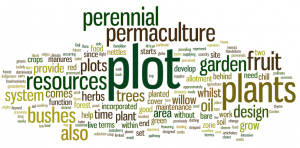From its origins to now
I have been working on one of my two allotment plots since late 2011 to convert the plot into a perennial permaculture food and resources system. All of the old wooden raised beds were moved to my other plot where I grow seasonal organic fruit and veg. The plot was effectively stripped bare other than the fruit trees and bushes that a permanent resource of the plot.
I then made an African keyhole garden at the top end of the plot and planted a circle of red willow which will develop into a partially shaded work and chill out area. Other work carried out since the end of winter has been the dotting about of various types of herbs and green manures to cover the bare soil around some of the newly planted fruit trees and bushes.
Which elements of permaculture are incorporated into the plot?
Zones – In terms of permaculture zones my allotment plots represent zone two as salad crops are grown at home in Zone 1, whilst crops and resources on the plots are mainly perennial or low maintenance and tree based. Luckily my plots are within a 3 minute walk of where I live. I grow all plant food/nutrients onsite such as comfrey and a range of green manures, which are then processed and used on site.
Forest Garden element – I have also incorporated a forest garden design in miniature which starts with a row of fruit trees, followed by sloe bushes, black currents, Jostaberry, raspberry and gooseberries, cranberries and Goji berries, tailing off from the soft fruit will be perennials such as Cardoons, globe artichokes, perennial broccoli, and sea kale when I plant them out in a few weeks time. Beyond these greens will be a selection of smaller herbs such as perennial Japanese Parsley, thyme, lemon balm and mint. I have also kept some of the plants that have previously been perceived as invasive such as Dandelions and ‘Forget me Not’s’ cleaver and nettles.
Using the edges – on the pathway side of my plot I have never cleared plants from where the fruit bushes stop and the grass of the path starts, Ive only ever cut them before they set seed, this seems to have helped with the diversity of plants on that particular edge.
On site Green Manures – The whole of the plot has been interlaced with red clover and fenugreek seeds to act as a soil binding ground cover whilst also providing valuable resources from the tops and flowering parts of the plants. The Dandilion and nettles that are the indigenous plants of the plot also provide nutrients to aid the fertility of other plants. Right at the back of the plot behind the shed there is a strip of land approximately 20 feet long where I grow and coppice willow from, I recently added another 20 willow cuttings to this area which will help absorb much of the water overflow that comes from the block paved garden behind my plot whilst supplying me with some extra resources when it comes to coppicing time.
Future plans for the plot
Once all of the food forest plants are in place, the next stage of the design is to add the physic garden, which will contain medicinal plants and herbs. Opposite the Physic garden will be the permaculture flower pond which will provide an oasis and chill out zone for the pollinating insects that are attracted to the flowers, they in turn will also help to pollinate other plants, trees and bushes within the system.
A plot for the future
My design motivation for this plot really comes from some of the nightmare scenarios that are occurring because of peak oil and climate change, depleting oil and random extreme weather changes have a detrimental effect on our capacity to feed the billions that live on our planet, so it is with scarcity in mind that my design seeks to address. In a time of very limited resources a perennial permaculture system can provide us with the resources that we need, agriculture and its heavily intensive annual crop growing cannot function without oil, permaculture systems can function and develop themselves without oil, once they have been designed and set up they need very little in the way of maintenance. In terms of good ecology, a healthy and diverse perennial plant system is good for the flora and fauna in the area where it is located.
Steve

